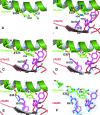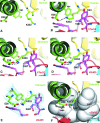Structural analysis of major species barriers between humans and palm civets for severe acute respiratory syndrome coronavirus infections
- PMID: 18448527
- PMCID: PMC2446986
- DOI: 10.1128/JVI.00442-08
Structural analysis of major species barriers between humans and palm civets for severe acute respiratory syndrome coronavirus infections
Abstract
It is believed that a novel coronavirus, severe acute respiratory syndrome coronavirus (SARS-CoV), was passed from palm civets to humans and caused the epidemic of SARS in 2002 to 2003. The major species barriers between humans and civets for SARS-CoV infections are the specific interactions between a defined receptor-binding domain (RBD) on a viral spike protein and its host receptor, angiotensin-converting enzyme 2 (ACE2). In this study a chimeric ACE2 bearing the critical N-terminal helix from civet and the remaining peptidase domain from human was constructed, and it was shown that this construct has the same receptor activity as civet ACE2. In addition, crystal structures of the chimeric ACE2 complexed with RBDs from various human and civet SARS-CoV strains were determined. These structures, combined with a previously determined structure of human ACE2 complexed with the RBD from a human SARS-CoV strain, have revealed a structural basis for understanding the major species barriers between humans and civets for SARS-CoV infections. They show that the major species barriers are determined by interactions between four ACE2 residues (residues 31, 35, 38, and 353) and two RBD residues (residues 479 and 487), that early civet SARS-CoV isolates were prevented from infecting human cells due to imbalanced salt bridges at the hydrophobic virus/receptor interface, and that SARS-CoV has evolved to gain sustained infectivity for human cells by eliminating unfavorable free charges at the interface through stepwise mutations at positions 479 and 487. These results enhance our understanding of host adaptations and cross-species infections of SARS-CoV and other emerging animal viruses.
Figures





Similar articles
-
Mechanisms of host receptor adaptation by severe acute respiratory syndrome coronavirus.J Biol Chem. 2012 Mar 16;287(12):8904-11. doi: 10.1074/jbc.M111.325803. Epub 2012 Jan 30. J Biol Chem. 2012. PMID: 22291007 Free PMC article.
-
Pathways of cross-species transmission of synthetically reconstructed zoonotic severe acute respiratory syndrome coronavirus.J Virol. 2008 Sep;82(17):8721-32. doi: 10.1128/JVI.00818-08. Epub 2008 Jun 25. J Virol. 2008. PMID: 18579604 Free PMC article.
-
Structure of SARS coronavirus spike receptor-binding domain complexed with receptor.Science. 2005 Sep 16;309(5742):1864-8. doi: 10.1126/science.1116480. Science. 2005. PMID: 16166518
-
Receptor recognition and cross-species infections of SARS coronavirus.Antiviral Res. 2013 Oct;100(1):246-54. doi: 10.1016/j.antiviral.2013.08.014. Epub 2013 Aug 29. Antiviral Res. 2013. PMID: 23994189 Free PMC article. Review.
-
Insights from the association of SARS-CoV S-protein with its receptor, ACE2.Adv Exp Med Biol. 2006;581:209-18. doi: 10.1007/978-0-387-33012-9_36. Adv Exp Med Biol. 2006. PMID: 17037532 Free PMC article. Review. No abstract available.
Cited by
-
6th International Conference on Emerging Zoonoses.Zoonoses Public Health. 2012 Sep;59 Suppl 2(Suppl 2):2-31. doi: 10.1111/j.1863-2378.2012.01539.x. Zoonoses Public Health. 2012. PMID: 22958247 Free PMC article.
-
Molecular mechanism of interaction between SARS-CoV-2 and host cells and interventional therapy.Signal Transduct Target Ther. 2021 Jun 11;6(1):233. doi: 10.1038/s41392-021-00653-w. Signal Transduct Target Ther. 2021. PMID: 34117216 Free PMC article. Review.
-
Molecular biology of the SARs-CoV-2 spike protein: A review of current knowledge.J Med Virol. 2021 Oct;93(10):5729-5741. doi: 10.1002/jmv.27132. Epub 2021 Jun 14. J Med Virol. 2021. PMID: 34125455 Free PMC article. Review.
-
Crystal structure of the receptor-binding domain from newly emerged Middle East respiratory syndrome coronavirus.J Virol. 2013 Oct;87(19):10777-83. doi: 10.1128/JVI.01756-13. Epub 2013 Jul 31. J Virol. 2013. PMID: 23903833 Free PMC article.
-
The Role of Host Genetic Factors in Coronavirus Susceptibility: Review of Animal and Systematic Review of Human Literature.Am J Hum Genet. 2020 Sep 3;107(3):381-402. doi: 10.1016/j.ajhg.2020.08.007. Epub 2020 Aug 12. Am J Hum Genet. 2020. PMID: 32814065 Free PMC article.
References
-
- Brunger, A. T., P. D. Adams, G. M. Clore, W. L. DeLano, P. Gros, R. W. Grosse-Kunstleve, J. S. Jiang, J. Kuszewski, M. Nilges, N. S. Pannu, R. J. Read, L. M. Rice, T. Simonson, and G. L. Warren. 1998. Crystallography & NMR system: a new software suite for macromolecular structure determination. Acta Crystallogr. D 54905-921. - PubMed
-
- Cowtan, K. 1994. Joint CCP4 and ESF-EACBM Newsl. Protein Crystallogr. 3134-38.
-
- Fenn, T. D., D. Ringe, and G. A. Petsko. 2003. POVScript+: a program for model and data visualization using persistence of vision ray-tracing. J. Appl. Crystallogr. 36944-947.
-
- Guan, Y., B. J. Zheng, Y. Q. He, X. L. Liu, Z. X. Zhuang, C. L. Cheung, S. W. Luo, P. H. Li, L. J. Zhang, Y. J. Guan, K. M. Butt, K. L. Wong, K. W. Chan, W. Lim, K. F. Shortridge, K. Y. Yuen, J. S. M. Peiris, and L. L. M. Poon. 2003. Isolation and characterization of viruses related to the SARS coronavirus from animals in Southern China. Science 302276-278. - PubMed
Publication types
MeSH terms
Substances
Grants and funding
LinkOut - more resources
Full Text Sources
Other Literature Sources
Miscellaneous

